Pioneering Swiss solar-powered aircraft Solar Impulse landed in Brussels on Friday after completing its first international flight, 13 hours after it took off from Switzerland.
“I captured more energy than I used,” said pilot Andre Borschberg as he descended from the plane amid the applause of hundreds of people including Belgium’s Crown Prince Philippe, who had followed Solar Impulse’s long descent from a helicopter.
“I flew with the power of a scooter,” Borschberg added.
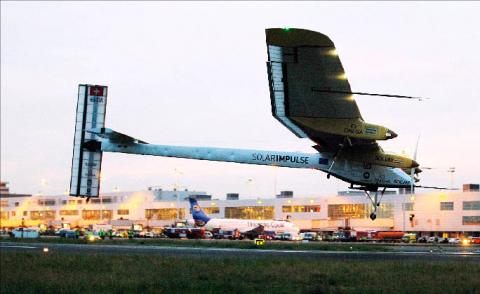
Photo: Reuters
“This is wonderful,” said Bertrand Piccard, joint founder and president of the Solar Impulse project.
The single-seater had lifted off gently in clear blue skies from Payerne airbase at 8:40am after being delayed by early morning mist.
It covered the roughly 480km from western Switzerland to Brussels airport, flying over France and Luxembourg at 3,600m.
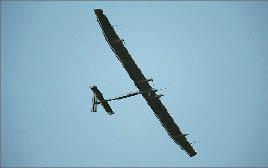
Photo: AFP
“With this flight, we would like to encourage politicians to opt for more ambitious energy policies,” Piccard said before the aircraft landed.
He also called for “a change in mentalities to encourage people to use new [green] technologies” and stop wasting fossil energies.
“It is crazy that mankind wastes a billion tonnes of oil an hour,” he added. “Who wants to believe that we will keep planes that burn up so much fuel?”
“The flight is going really well, I have just flown over Liege, it’s a real pleasure to enter Belgian airspace,” Borschberg said as the dragonfly-like experimental and emissions-free aircraft cruised at 50kph.
“The view I have here is extraordinary,” the Swiss pilot added in a live feed over the Internet. “I’m above the clouds, for now I’m taking advantage of the blue sky.”
Solar Impulse HB-SIA, which has the wingspan of a large airliner, but weighs no more than a sedan, made history in July last year as the first manned plane to fly around the clock and through the night on the sun’s energy.
It holds the endurance and altitude records for a manned solar-powered airplane after staying aloft for 26 hours, 10 minutes and 19 seconds above -Switzerland, flying at 9,235m.
The high-tech plane has since flown several times, notably between Geneva and Zurich airports, but the journey to a busy airport in Brussels through crowded airspace was regarded as a new test.
“Flying an aircraft like Solar Impulse through European airspace to land at an international airport is an incredible challenge for all of us, and success depends on the support we receive from all the authorities concerned,” said Borschberg, who also piloted July’s flight.
The HB-SIA relies on 12,000 solar cells on its 64m wings to charge the batteries that provide the energy for the 10-horsepower electric motors driving four propellers. Its record-breaking flight last year demonstrated its capacity to store up enough energy to fly through a summer night.
The showcase for green technology will be on display at Brussels airport until May 29 before flying to the international air show at Le Bourget in Paris from June 20 to June 26.
“This time, we have a real airplane — flying —- proof that new technologies can reduce our dependence on fossil energy,” Piccard said.
The Solar Impulse team is planning to fly even further, including possible transamerican, transatlantic and round-the-world flights — in stages — in 2013 and 2014 using a slightly larger aircraft.
Asked about upping the speed, Borschberg said: “That’s not the aim of this plane for now.”
Piccard, himself the first man along with Briton Brian Jones to fly non-stop around the world in a balloon, comes from a dynasty of pioneers.
His grandfather Auguste Piccard twice beat the record for reaching the highest altitude in a balloon, in 1931 to 1932.
His late father Jacques Piccard was a deep sea explorer who holds the record for traveling to the deepest point underwater, 10,916m below sea level in the Marianas Trench in the Pacific.
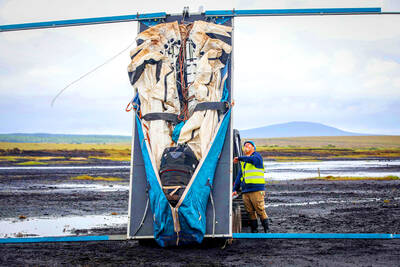
On Ireland’s blustery western seaboard, researchers are gleefully flying giant kites — not for fun, but in the hope of generating renewable electricity and sparking a “revolution” in wind energy. “We use a kite to capture the wind and a generator at the bottom of it that captures the power,” said Padraic Doherty of Kitepower, the Dutch firm behind the venture. At its test site in operation since September 2023 near the small town of Bangor Erris, the team transports the vast 60-square-meter kite from a hangar across the lunar-like bogland to a generator. The kite is then attached by a

Foxconn Technology Co (鴻準精密), a metal casing supplier owned by Hon Hai Precision Industry Co (鴻海精密), yesterday announced plans to invest US$1 billion in the US over the next decade as part of its business transformation strategy. The Apple Inc supplier said in a statement that its board approved the investment on Thursday, as part of a transformation strategy focused on precision mold development, smart manufacturing, robotics and advanced automation. The strategy would have a strong emphasis on artificial intelligence (AI), the company added. The company said it aims to build a flexible, intelligent production ecosystem to boost competitiveness and sustainability. Foxconn
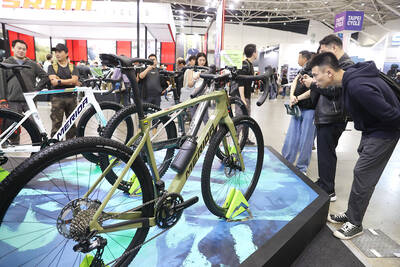
Leading Taiwanese bicycle brands Giant Manufacturing Co (巨大機械) and Merida Industry Co (美利達工業) on Sunday said that they have adopted measures to mitigate the impact of the tariff policies of US President Donald Trump’s administration. The US announced at the beginning of this month that it would impose a 20 percent tariff on imported goods made in Taiwan, effective on Thursday last week. The tariff would be added to other pre-existing most-favored-nation duties and industry-specific trade remedy levy, which would bring the overall tariff on Taiwan-made bicycles to between 25.5 percent and 31 percent. However, Giant did not seem too perturbed by the
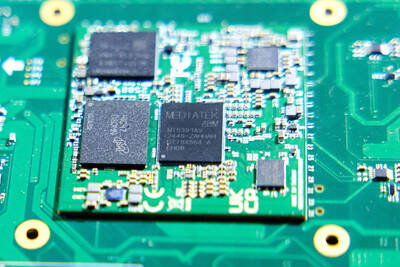
TARIFF CONCERNS: Semiconductor suppliers are tempering expectations for the traditionally strong third quarter, citing US tariff uncertainty and a stronger NT dollar Several Taiwanese semiconductor suppliers are taking a cautious view of the third quarter — typically a peak season for the industry — citing uncertainty over US tariffs and the stronger New Taiwan dollar. Smartphone chip designer MediaTek Inc (聯發科技) said that customers accelerated orders in the first half of the year to avoid potential tariffs threatened by US President Donald Trump’s administration. As a result, it anticipates weaker-than-usual peak-season demand in the third quarter. The US tariff plan, announced on April 2, initially proposed a 32 percent duty on Taiwanese goods. Its implementation was postponed by 90 days to July 9, then